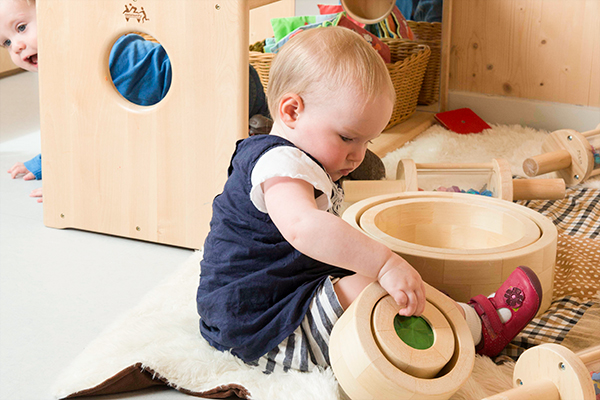THE HEURISTIC GAME: WHAT IT IS AND HOW IT TAKES PLACE
Heuristic play is rooted in the natural curiosity of young children. As children get older, they go from just being happy to play to meditating on objects and wanting to find out what can be done with them. The little ones have the desire to manage things: collect, fill, stack, select and manipulate in many ways. THE HEURISTIC GAME: WHAT IT IS AND HOW IT TAKES PLACE
As any parent knows, household or kitchen utensils offer this type of activity and can keep children busy for extended periods of time. When young children make a fun discovery – for example when one element fits into another or an interesting sound is produced – they often repeat the action to get the result back. This strengthens their cognitive development as well as muscle control and hand / eye coordination.
In their book, People 0-3, Elinor Goldschmied and Sonia Jackson coined the term “heuristic play” to explain how to provide children with more structured play activities. The heuristic game consists in offering a group of children, for a defined period of time, in a controlled environment, a large number of different objects and stimuli with which to play freely without the intervention of adults. This is particularly useful for infants in the second year of life, who often seem unwilling to do an activity for more than a few minutes.
The term “heuristic” literally means helping to discover or discover through error and trial, the root is common with the term “Eureka” which means I have found it!
Clare Crowther of Bridgwater College describes heuristic play as a useful activity for one, two, or three-year-olds, which gives them the opportunity to spontaneously experiment with a range of commonly used objects.

During the heuristic play session, adults must remain seated and calm. This helps children make their own choices and discoveries.
The heuristic game with objects is not a new idea. Think for example of the age-old charm that the mother’s sewing basket has on children: while the mother is worried, the child savors its contents in various combinations: spools of thread, pieces of colored ribbon, fragments of thread and fabric, a pincushion filled with pins, a tape measure and buttons of all shapes, sizes and colors. The heuristic game represents the same concept, but takes place with groups of children and many types of different objects.
Natural materials such as pine cones, shells and pebbles can be used to organize a heuristic play session, as well as ribbons, chains, curtain rings, jar lids, sturdy cardboard tubes, empty snails of masking tape and empty cotton reels (the Blank ribbon snails are especially popular. Some are slightly sticky due to the ribbon, so kids have fun sticking and peeling them). It is necessary to check the cleanliness and safety of the objects offered, discarding unsuitable objects and proposing new ones.
The ideal habitat for heuristic play is a large empty floor in which the objects will be distributed, it is important that there are the same objects in sufficient numbers for each child so that they do not feel compelled to protect their own. It is indeed premature to think that children, at this age, already understand the concept of sharing.

Another interesting aspect of the heuristic game is its social quality. Although every child is involved in their own business, they always have a watchful eye on others and sometimes find themselves doing activities in a group.
Furthermore, we must not forget that the heuristic game offers a great opportunity for adults: that of observing how the child acts outside the tasks assigned to him. It is exciting to witness the mental processes of children. I saw a child thread a thin tube into a larger one, repeat the action, then try to slide a larger object through the tube. After several attempts he realized that the action was not possible and he tried again with another object. Another child dropped a cork into a cone-shaped reel, after unsuccessfully attempting to reach it with his hand, shook the cone, and when the cork (to his surprise) flew out, he repeated the procedure. .
At the end of the session, the children help to collect the objects. A two year old is able to put items in the right bag while younger children are still unable to recognize which bag is the right one. For kids, the cleaning process is just as fun as playing, after all, dropping an object into a bag is just as fun as dropping it into a box!
The heuristic game is an approach and not a prescription. There is no one right way to do it and there are no right objects and wrong objects, it all depends on the context. I’ve seen heuristic play materials contained in homemade jute bags, wicker baskets and boxes. No matter how many objects we provide in this type of activity, what is important is that the meaning of spontaneous exploratory play is recognized for the development of children.
THE HEURISTIC GAME: WHAT IT IS AND HOW IT TAKES PLACE, THE HEURISTIC GAME: WHAT IT IS AND HOW IT TAKES PLACE see complete details on this
Have fun!




